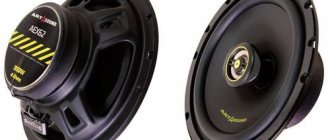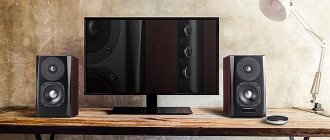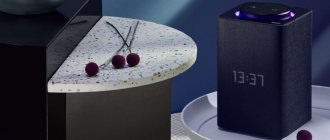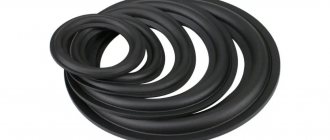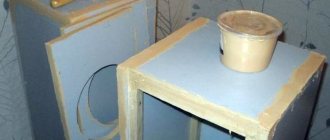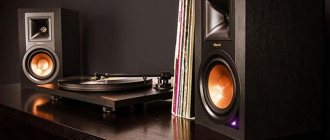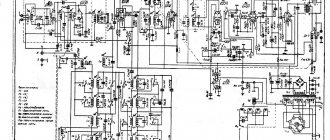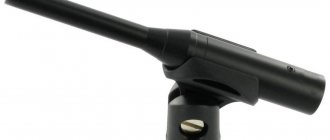In this section we usually present the latest new products, but today the established rule will be broken. “Hotline” is dedicated to the Canton Ergo family of acoustic systems, which have been produced since 1980. The series has gone through six modernizations in its lifetime and continues to enjoy the love of music lovers.
COMPONENTS
- CD player Denon DCD-2010AE (RUB 85,990)
- Integrated amplifier Denon PMA-2010AE (RUB 89,990)
- AV receiver Denon AVR-4520 (RUB 124,990)
- Interconnect cables RCA Black Rhodium Phantom DCT++ (RUB 22,600)
- Subwoofer cable RCA Black Rhodium Phantom DCT++ (RUB 26,000)
- Speaker cables BlackRhodium Ninja DCT++ (RUB 105,000)
- Power cables ISOL-8 (RUB 29,000)
Ergo acoustics with enviable regularity emerge as winners in comparative tests, ahead of many more innovative and ambitious competitors. But they are not even the top of the Canton model range. It’s just that from the very beginning this line included proven and sound ideas, which we want to introduce you to.
It is unlikely that Ergo is the face of the Canton company located near Frankfurt; rather, it is its soul. In the internal hierarchy, they are the middle of a diverse range of hi-fi acoustics, but the middle is literally golden. The classic finish with natural veneer with characteristic rounded ribs is from the eighties. From the same time - a metal perforated grill instead of an acoustically transparent fabric boot, and a black velvet covering of the front part to minimize reflections.
Of course, the current seventh generation Ergo is structurally different from the earliest ones. With regularity, every five or six years, engineers made some changes. In the nineties, floor-standing models began to be made in the form of towers with internal struts and a certain aspect ratio - the most successful for suppressing internal resonances. Midbass drivers with paper and polymer diffusers were later abandoned in favor of aluminum ones, but the tweeters, as before, are dome-shaped from a special aluminum-manganese alloy. Only in 2003 their design changed - flat flanges were replaced by concave waveguides to improve dispersion.
In modern models, drivers do not have drivers, but they have an S-shaped elastic suspension. Please also note that the caliber of the midrange and bass heads for different systems is either the same or differs only by a couple of centimeters. This decision also did not come out of nowhere: emitters that are different in purpose and electromechanical characteristics, but similar in size, are easier to coordinate with each other. When designing crossovers for Ergo, Canton engineers also adhere to certain principles. The band separation should be quite steep, at least 12 - 24 dB/oct., but the filter circuit should not be too complex and cause significant impedance spikes and dips. And such linearity, which significantly simplifies matching with an amplifier, is achieved in another way - the heads are initially optimized so that outside the operating range they have a steep decline in frequency response. For low-frequency drivers, Canton even came up with a separate “trick” - Displacement Control. Its essence is that the sensitivity of the speakers to ultra-low frequency signals, which at high amplitudes leads to distortion and modulation, is as low as possible, and to the useful signals of the operating range remains equally high. And this, as you might guess, is a non-trivial task.
The speakers currently offered in the Ergo line are available in three finishes: wenge, cherry and black ash. We tested shelf and floor-standing models in a conventional stereo configuration. But then we actually repeated the tests, using an advanced AV receiver, to systematically evaluate the “theatrical” components of the Ergo - the center channel and the active subwoofer.
Ergo 610
Ergo 610 || Number of stripes: 2 || Crossover frequency: 3000 Hz || Input power: nominal 60 W, maximum 100 W || Nominal resistance: 4 - 8 ohms || Sensitivity: 86 dB/W/m || Playback range: 40 - 40000 Hz || Dimensions: 205 x 340 x 95 mm || Weight: 4 kg (each) || Price: 29,000 rub. (per pair)
The lightest and smallest Ergos look just as solid as the larger models in the series. Behind the steel grill are a 180mm midwoofer and a signature Canton tweeter with an inch dome. However, these speakers can hardly be called bookshelf speakers due to their shallow depth. The 610s are great as wall speakers. The rear part is equipped with a mounting eye. This is the only model in the Ergo range with a closed design and is also available in a matte white finish.
If these monitors are placed on stands in a free field, you will most likely experience a lack of both bass and lower mids. But the middle and high registers will be maintained in the best traditions of Canton. It is difficult to notice even some unpleasant tint. The sound flows easily, like silk, unobtrusively and at the same time not muddy, but with good microdynamic elaboration. If you place the speakers close to a large reflective surface or hang them on the wall, then the subjective tonal balance will change. Now, starting from 70 - 90 Hz, the bass will be linear, it will even have a very clear and intense attack, and higher in the spectrum it will organically and without failures move into the middle. At the same time, the formed images become larger and, as it were, more vocal. The amazing thing is that even when placed on the wall, the music stage does not become flat. Distant plans move closer to the foreground, but volume is maintained due to the fact that the space opens up slightly towards the listener. Focusing does not deteriorate at all. So Ergo 610 is not only for the rear. In a small room they can easily cope with the duties of a stereo pair.
Sound: detailed and seamless
I listen next to Sylvain Luc’s “Trio Sud” disc. This also has its own specifics - the sound of the acoustic guitar is slightly exaggerated on the recording, the bass is too soft, slightly swollen and blurred, and a large number of transitions from quiet, almost solo fragments to the simultaneous mixing of all instruments.
When listening, I was pleased with the intelligibility: instead of a sound mess, the result was musical unity. With good detail and simply excellent dynamics, the acoustics do not imply a rigid dissection of the music into individual sounds - the picture in any case remains integral. The acoustics convey emotions in a somewhat unusual way - everything seems to be audible, but a little strictly, restrained and conservative. And although there were no obvious overflows, I could not shake the feeling that it was about to overflow. Whether this is good or not - if possible, everyone will decide for themselves. Since all the effects are expressed very subtly, it is extremely difficult to give them an unambiguous assessment.
Yes, the speakers play strictly, even a little dryly, but at the same time very detailed. And this detail makes you want to consider each sound separately. But at the same time, music, as something whole and complete, envelops you. And this dialectic does not interfere with listening in any way; on the contrary, it captivates you - you want to listen and listen.
The next album is Richard Hawley's "Truelove's Gutter". Here I liked the accurate, detailed and three-dimensional reproduction of almost every note, as well as the fact that the music remained music. A slight coldness did not harm this album at all, and the absence of any other coloring - even more so. The information content of listening is high, but emotions, although they fade into the background a little, are still easy to read. In terms of presentation of the frequency range, everything here is equally good - bass, mids, and high frequencies - everything is solid and smooth. True, the stage was scaled larger than the recording required - the acoustics were still impressive, so listening to the tracks was a little unusual.
Ergo 620
Ergo 620 || Number of stripes: 2 || Crossover frequency: 3000 Hz || Input power: nominal 70 W, maximum 130 W || Nominal resistance: 4 - 8 ohms || Sensitivity: 86 dB/W/m || Playback range: 33 - 40000 Hz || Dimensions: 205 x 340 x 275 mm || Weight: 7.5 kg (each) || Price: 35340 rub. (per pair)
Externally, the 620 monitors are no different from the younger model. Everything matches: the caliber and location of the heads, width and height... But due to the deep body, they are much larger in internal displacement. The woofer used here is optimized for a bass reflex, the port of which is brought out to the rear. In the Ergo series, this model is now the only one that can be called a classic two-way monitor. Previously, there were larger bookshelf speakers, with a 20-centimeter midbass, but the most deserved one was left in production - the 620s, like its predecessors, have countless awards.
The manufacturer recommends using LS650 stands in this case, which is what we did. First observation: the acoustics work out the full range without the slightest effort! The sound is much more open compared to the 610s, I would even say frank. A direct contact is established between the listener and the music.
The tonal picture fits perfectly with the spatial one. The images are very material and, moreover, three-dimensional in themselves. For example, an ordinary acoustic guitar was recorded. But it is reproduced not as an image collected together, but as a projection - the wooden soundboard is localized widely, the strings are localized pointwise, and the fingers moving along the fingerboard are clearly audible a little to the side. You can tell if the guitarist is right-handed or left-handed. And, looking ahead, I will say that in terms of “holographicity” it is difficult to find equals for these systems in the Ergo line. Listening to classics, opera, and large symphony compositions on them is a pleasure. Although in the latter case it would not hurt to support the subwoofer at the lowest frequencies. A large hall is better perceived when its infra-low “breathing” is heard, which no monitors are capable of reproducing on their own.
Ergo 670 DC
Ergo 670 DC || Number of stripes: 2 1/2 || Crossover frequency: 300, 3000 Hz || Input power: nominal 110 W, maximum 170 W || Nominal resistance: 4 - 8 ohms || Sensitivity: 87.5 dB/W/m || Playback range: 25 - 40000 Hz || Dimensions: 21.5 x 950 x 285 mm || Weight: 17.3 kg (each) || Price: 61420 rub. (per pair)
I was about to write that the 670th model is obtained from the 620th by increasing the height of the case and adding a band (externally the midrange and high-frequency heads are the same), but in time I remembered that in all Ergo floor-standing speakers the tweeter is always at 180- millimeter midrange, and not vice versa. Moreover, in the 670 model, all this is reminiscent of the D'Appolito scheme, since another 180 mm speaker with an aluminum diffuser is symmetrically located below. However, after removing the grill, we see that the heads are different. The bottom driver has different characteristics and provides midrange support in the bass area. Simply put, this is a 2.5-way system with overlap below 300 Hz. By the way, it allows a four-wire connection.
In terms of tonal signature, the lower-end floorstanding speakers are very similar to the 620s - neutrality and neutrality again, from the bottom to the very top. Not the slightest annoying tint! There is no more or less bass, it’s just that the lowest notes emerged and became more noticeable (you should definitely refuse subwoofer assistance here so as not to destroy the integrity of the lower register). Harmonic intelligibility in the midrange is as clear and deep as on the 620s. It turns out that we have floor monitors in front of us? The advantage of such systems is that they are not so limited in frequency and dynamic range, but at the same time they impress with the accuracy and neatness of the sound, and not with its strength. Among the fundamental differences, I will mention a more fundamental background, as well as a tendency to present foreground images denser and larger. But even such a space can be brought to a three-dimensional ideal if the listening point is slightly removed from the stereo base. I would recommend the 670s to anyone looking for monitors for a room larger than 30 - 35 m2.
conclusions
Very versatile acoustics. The sound is undoubtedly accurate and uncolored. The detail and dynamics are very high, while there is even elaboration of the entire range; dips or restrictions at the edges are not felt at all. The genre versatility is obvious. Add to this the outstanding scale and volume - the acoustics themselves are large, and this is not only obvious, but also audible. It is absolutely impossible not to take into account the size of the room when choosing such a model. And it’s worth thinking about the properties of the room itself.
There is some specificity in the presentation - a slight emotional detachment, severity, although not turning into obvious harshness and not accompanied by excessive harshness. In different systems and with different components, the character of the sound will definitely change, so I would recommend avoiding, on the one hand, using components (amplification) with a sharp, harsh or emphatically bright sound. However, devices with a clearly warmed, softened or washed-out sound also do not look suitable, especially if you want to get the detail and dynamics that these acoustics are capable of.
Ergo 690 DC
Ergo 690 DC || Number of stripes: 3 || Crossover frequency: 300, 3500 Hz || Input power: nominal 170 W, maximum 320 W || Nominal resistance: 4 - 8 ohms || Sensitivity: 88.3 dB/W/m || Playback range: 20 - 40000 Hz || Dimensions: 230 x 1050 x 305 mm || Weight: 23.5 kg (each) || Price: 79900 rub. (per pair)
We already see significant changes in this model. The body is larger in size in all directions. Judging by the different crossover frequency between MF/HF, as well as the increased rated power, the 690s have a tweeter with different parameters, although outwardly it does not differ from those found in other Ergo models. But the main difference is a full-fledged three-way circuit, moreover, a pair of 20-centimeter woofers is used in the low end - of course, with aluminum diffusers and an S-shaped suspension. Another inconspicuous but important detail: the bass reflex, placed forward, is located significantly closer to the floor than in the 670s. In combination with the reflections that occur between the floor and ceiling of the listening room, this often makes it work more efficiently. Let me summarize: by all indications, this is an acoustic system for lovers of killer bass and loud music.
I wasn't wrong. The 690s are full-length sound. The younger floor speakers communicate with the listener on a first-name basis, while these speakers clearly speak on a first-name basis. They are louder, they have higher sensitivity, more abundant (which does not mean more accurate) detailing. And the impact of sound can probably even cause a slight concussion. At the same time, the pattern in the mid-high and high bands turns out to be gentle, with slightly compressed dynamics, suppressed by the “ringing”. At medium volume levels, listening to music on the 690 DC is not very interesting. Nonlinearity is captured, but this is not yet compensated for by dynamic prowess. But this does not mean that the 690s will always have to be “cranked up to full.” They create a very cozy and warm sound atmosphere when operating at low volumes. And under such conditions the scene turns out much more lively.
Ergo 695 DC
Ergo 695 DC || Number of stripes: 3 || Crossover frequency: 300, 3500 Hz || Input power: nominal 200 W, maximum 350 W || Nominal resistance: 4 - 8 ohms || Sensitivity: 89 dB/W/m || Playback range: 20 - 40000 Hz || Dimensions: 260 x 1150 x 345 mm || Weight: 32.2 kg (each) || Price: 99900 rub. (per pair)
Do not look for information about this model on the company’s website or in the catalog for the 2012 - 2013 model year. The company has stopped producing the largest and most expensive floor-standing acoustics in the Ergo series. But, as it turned out, it was temporary. At the request of dealers and their customers, these majestic systems will soon return to the market - verified information.
At one glance, it is clear that the 695s are the flagships of the Ergo model range, its pinnacle. In terms of mass, they significantly exceed the 690s. The buildings, in fact, look like skyscraper towers. But they have no fundamental differences from the three-strips described above. The heads that reproduce mid and high frequencies are the same. A pair of low-frequency drivers are also working in the bass band, only their caliber has been increased to 220 mm. Separation filters do not differ in basic parameters. The terminals also allow bi-amping connections.
And the latter, by the way, is highly recommended. Not because the amplifier has a hard time - on the contrary, the high sensitivity of the acoustics makes it easier for it and allows it to sound a large room without much effort. But only with separate amplification can the enormous musical potential of the flagships be realized 100 percent. The advantage of these speakers is that they do not know the concept of compression. They are linear not only in frequency response, but also in amplitude, which makes the sound dynamics extremely realistic. And if you feel that the sound is being clamped in some area, there is a hint of sluggish and slow playback of the attack, then you need to try bi-amping for better control. As with any high-class acoustics, you need to work with the Ergo 695 DC: carefully select all system components, cables, and means of acoustic treatment of the room. By the way, special attention is paid to the room - choosing the optimal listening point and speaker placement is very important. If they are placed in "neutral zones" where they will not cause resonances, the result will be a sound stage in every imaginable detail and with very realistic images. Don't try to place the 695s against a wall or with a wide stereo view. It's better to consciously go through the inconvenience to get the true Ergo sound. Of course, the 695s deserve this kind of treatment.
Sound: man and sea
If we take heavier music, for example, the My Dying Bride album “The Dreadful Hours”, we can conclude that the acoustic detail and truth are very high. While listening, you can clearly hear nuances that are often completely lost on other systems. However, the emotional component was unexpected for me: the acoustics clearly like the minor mood better, but there is no feeling of immersion; rather, it turns out to be a calm contemplation, although the emotional picture being contemplated fully corresponds to the work. Yet the level of emotional interaction between the listener and the music is less. To some extent, this is due to the fact that part of the attention is drawn to high detail, or perhaps due to the restraint and slight detachment of the sound.
12-inch woofer - in the entire line only Canton Reference 1 K has such drivers
To better illustrate these sensations, I will try to give this analogy - communication between man and the sea. Someone needs to take a swim, feel their body in the water, not paying attention to anything. But some people simply need the proximity of water, to see its various states - in a storm and in a calm, in the rays of the setting sun and in the light of the moon. Formally, immersion and direct contact do not occur, but the range of sensations is incomparably wider and deeper. Also with this particular listening to the acoustics being tested - this is rather the second case.
Another recording to listen to as part of the test is Cecilia Bartoli, Andras Schiff “Italian Songs”. Again, everything is excellent in terms of dynamics and detail, the scene is constructed correctly, there is not a hint of confusion or confusion anywhere. And although everything is there, this recording lacked a certain airy-emotional involvement for me. With almost holographic accuracy, knowing well what was recorded on the disc, including the meaning of these very songs, the effect of some detachment and understatement remained. However, I understand how different things Italy and Germany contributed to musical culture (at a time when there was neither a single Italy nor a single Germany), and I feel a little bit of this difference in musical culture, its emotional and semantic fullness. But here’s what’s interesting: for acoustics to emphasize such subtle moments—I’ve seen this very rarely. Typically, the nature of the technique is less multifaceted and less multi-layered.
Measurement results included with the acoustics
And the last entry in the test is Mahler's First Symphony, performed by the Chicago Symphony Orchestra under the direction of Klaus Tennstedt. It may not be the best performance, but both the recording and its modern edition are excellent. The air, the quiet sounds, the different groups and instruments in the orchestra are all beautifully recorded here.
First, let's go over the formal features. Wonderful stage, outstanding sound scale, ample amount of air. The orchestra can be heard very well, accurately and reliably. The dynamics, even in complex fragments, do not cause any complaints, and the detail also always remains confidently high. You can just listen and enjoy. Moreover, we are talking about large acoustics with an impressive sound, which is always very critical for symphonic music. Although it is worth noting that it is always somewhat easier for large floor-standing players to play such recordings than for bookshelf players (and those who are fully capable of this can be counted on one hand). But I’m testing floor-standing speakers, and comparisons here can be left at the level of theorizing, but in fact it turns out that any acoustics that play symphonic music fully and without quibbles are a rarity.
Ergo 655 Center
Ergo 655 Center || Number of stripes: 2 1/2 || Crossover frequency: 350, 3000 Hz || Input power: nominal 110 W, maximum 160 W || Nominal resistance: 4 - 8 ohms || Sensitivity: 87.9 dB/W/m || Playback range: 20 - 40000 Hz || Dimensions: 530 x 205 x 285 mm || Weight: 10.5 kg (each) || Price: 23880 rub. (per pair)
The Ergo model, designed for sounding the central channel, is completely in harmony in style and finish with other speakers in the series. But at the same time, it was designed non-standardly. What you see on the front part repeats the design of the floor-standing Ergo 670: the same set of heads, the same filters, bass reflex design and the same 2.5-way circuit. I will also note that the bass of these systems is not cut off, as happens with some central systems, so nothing prevents them from being used for other channels. A pair of 655s makes an excellent stereo system, for example.
It would seem that this model should be reminiscent of the 670 in terms of tonal and dynamic patterns, but don’t rush to conclusions. We were not too lazy to check the center for identity with all Ergo systems. Without limiting the range, without coordinating the level and time delays, we simply turned on the 655 in mono mode in a regular stereo configuration, placing it exactly in the center and at the same distance from the listening point as the front speakers. If it turned out that the added channel attracted voices, virtual sources, or made changes to the tonal picture, then these were signs of disharmony. And they were noted with all bookshelf and floorstanding speakers except the 690s. Complete mutual understanding reigned among this trio, and the sound panorama became even more realistic - the images became more material, the localization improved, and distant shots received a larger scale. We can talk not only about the equal sensitivity of the systems and the similarity of the tonal pattern - I will assume that their phase and transient characteristics are similar.
This does not mean that the center cannot be used with other Ergo models. With additional settings in the AV receiver - please, no contraindications! But with the 690s, excellent results are obtained without any settings at all. And the ideal Ergo-based multi-channel system would include 690s as the main and 655s as both the center and systems for all auxiliary channels.
Sound: open and strict
To start, I put on Coleman Hawkins' "Good Old Broadway" CD. This is a very good digital reissue of an old recording, on which you can hear all the features introduced by the technology of those years. It happens that modern equipment plays such recordings dimly and flatly, giving preference to severely overcompressed editions of recent years. Usually the source is blamed for this, but acoustics can also make a significant contribution to the picture, as I have seen more than once. But here I heard a clear, detailed open sound with excellent nuances and completely unpressed dynamics.
There was no harshness in the sound as such (and the previous Canton Reference series had a noticeable amount of harshness), rather the sound was harmonious, moderately strict, without noticeable coldness or, on the contrary, warmth, perhaps a little dry. Or it’s just that old records themselves are more associated with a certain specificity inherent in them. The detail is high throughout the entire range, which, in turn, was worked out fully, without dips or distortions, the low-frequency section is not late. All instrumental parts with all sounds and overtones were clearly audible. The scale of the sound picture of the acoustics is truly impressive. The bass, as far as it can be assessed from this recording, is deep, fast and spacious. The mids are light, transparent, slightly cool, the same can be said about the upper frequencies.
The next album is Nicki Parrott & Ken Peplowski “Like A Lover”. The specifics of Venus Records releases are assessed differently, but this particular recording contains a very thick, viscous, but at the same time detailed and multifaceted bass. And the acoustics presented it as it is - powerful, large-scale, but not rude or heavy. The lower mids and upper bass were processed accurately, without clogging or masking the mid-frequency range.
I would like to note the multifaceted and correctly constructed stage, as well as the vocals, which sounded very detailed. Except that everything was played a little more strictly and dryly, and this is unusual. Although if you listen to all the components of the recording, you come to the conclusion that the picture as a whole is accurate and plausible. And another plus is speed: transitions, attenuation of notes, the ratio of quiet and loud sounds - the acoustics play all this not just well, perfectly! There is no feeling of the sounds fading away too quickly, but there is also no prolongation or feeling that the sounds are rushed or delayed.
SUB 650
SUB 650 || Cutoff frequency: 45 - 200 Hz || Input power: nominal 200 W, maximum 300 W || Playback range: 20 - 200 Hz || Dimensions: 360 x 480 x 500 mm || Weight: 23.5 kg || Price: 54800 rub.
The name of this subwoofer does not contain the word “Ergo”, but this “unidentified” component is one hundred percent offspring of the family. This is visible not only in the finishing. The weight and size characteristics are completely identical to those of the previously produced Ergo AS 650.2 SC. And the design is similar: a 310-mm head on the facade, a bass-reflex design with a port that is directed to the floor, an identical connection and adjustment panel (there are “hot” inputs, low-level outputs are provided, there is a smooth adjustment of the phase and crossover cutoff frequency). The terminal section here is new and, it seems, traditional class AB.
Don't doubt the 650 SUB's ability to produce solid sound pressure. There is plenty of power here. What’s more important is that this bass machine has neither “boxy” overtones nor protracted bass-reflex “mumble.” The bass is accurate and extremely clear. We tested it for falsehood in the most difficult matching mode - when the reproduced bands overlap as much as possible and the subwoofer is required not so much to support as to be able to hit the beat. The available settings are quite enough to produce a cohesive and harmonious low end with a clear and dense structure, even when paired with flagship models. But it also finds a common language with other Ergo speakers. It’s enough to start by expanding the range of the bass machine to its full width, adjusting the phase to achieve maximum bass gain (if that doesn’t work, move the sub closer to the listening point), and then adjust the frequency and level so that the lower register sounds linear. The main thing is not to place the SUB 650 in a corner or close to it. There will definitely be problems with clarity.
Ceramics speakers
The Reference 1 K has a three-way design and a bass-reflex design of the low-frequency section. I note that the port is not located on the front or rear surface, but downwards, and is directed into the massive base of the speaker. But the most interesting thing about the design is, of course, the speakers. Here, aluminum diffusers, traditional for many Canton models, are replaced by metal-ceramic membranes.
Canton Reference 1K Midrange Speaker
And although the use of ceramics for such purposes occurs, this solution is still quite expensive and therefore rare. Here it is doubly interesting, since these are not ready-made speakers with ceramics in the designs purchased from someone, but their own developments.
No less significant is the fact that metal-ceramics in its various variations is used in all emitters of the Reference K line - these are dome tweeters, mid-frequency drivers, and low-frequency radiators. It is clear that a variety of materials of different compositions are used for the tweeter dome and the rest of the speakers, but all related to a combination of metals and ceramics.
The purpose of using such diffusers is clear - to achieve the greatest mechanical stability and precise operation of the speakers with minimal intrinsic coloration. For the same purposes, complex suspension profiles are used (I mentioned them earlier) and all other design elements, the total result of which comes down to creating the very performance characteristics and the sound that the developers intended.
The tweeter with a metal-ceramic dome is covered with a non-removable protective mesh
Canton Reference 1 K is a truly large speaker designed to work in large rooms. The manufacturer does not give exact recommendations, but even if you just estimate speculatively, the 134 kilograms of weight of each speaker and a total of four 12-inch woofers are difficult to fit into small rooms. It is also worth mentioning that these same dimensions and inches of woofers are very significant for many audiophiles - there have been so many disputes, how many beliefs exist that without a 12-15-inch bass driver there can be no full-size acoustics. And in many ways these statements are justified.
The acoustic bodies, despite their impressive size, look very elegant, primarily due to well-calibrated proportions and smoothed lines. This acoustics is far from the concept of a “box”. Massive bases also complement the design well. The cases of all Canton Reference K models are made of multi-layer laminate 5 centimeters thick. The manufacturer does not disclose the detailed composition of the sandwich, but the shells are clearly rigid and well damped.
Canton Reference 1 K speaker guards are made of two parts
The finish is strict, with options including black or white piano lacquer of excellent quality. The design also has neat, removable grills with magnetic mounts. What’s good is that the grills consist of two parts, one covers the low frequencies, and the second covers the mid frequencies and tweeter. A convenient solution that, if desired, allows you to cover only the low-frequency speakers, for which the presence of acoustic fabric is much less critical. By the way, separate grills are used not only in the “unit”, but also in younger floor-standing models.
The massive base of the acoustics into which the bass reflex port is directed. Also in the photo you can see some kind of waveguide
The support legs are metal, their design is simple. The only thing that can cause inconvenience is the sticker inserts on the legs, designed to avoid damaging the floor surface. It is not recommended to drag the acoustics, although with such a weight, any implementation of supports (except for wheels) is unlikely to make life easier for the owner - 134 kilograms does not imply options for easy movement.
In terms of functionality, the acoustics allow you to use a conventional connection, bi-wiring or bi-amping. I am very skeptical about bi-wiring, but using separate amplification can come in handy here - it takes a lot of power to drive such acoustics.
Switching terminals and jumpers designed for adjusting operating parameters
In this case, I was not able to see crossovers, but I saw those that were used in the previous line - a very high-quality and solid design with a good element base. On the rear panel of the speakers there are special jumpers that allow you to separately adjust the operation of the crossover in the low-frequency/mid-frequency section (from 100 to 300 Hz) and the tweeter (from 7 to 28 kHz) in the range of -1.5/0/+1.5 dB. A useful function is that the adjustment helps take into account some of the acoustics of the room and correct the nuances of sound, for example vocals.
By the time of the test, the acoustics had already worked sufficiently and were warmed up. In terms of placement, I had to trust the layout prepared for the test - it was not possible to move the columns during the process. However, the installation was carried out by good specialists, so I had no desire to change anything.
Test system: Mark Levinson No.585 integrated amplifier and McIntosh MCD550 CD/SACD player
Based on the test system, I have heard different Cantons paired with Mark Levinson before. Both manufacturers have complete order with continuity, so I expected predictable compatibility. According to my observations, this acoustics requires excellent quality, powerful amplification, and Mark Levinson fits this definition quite well, but then options are possible.

